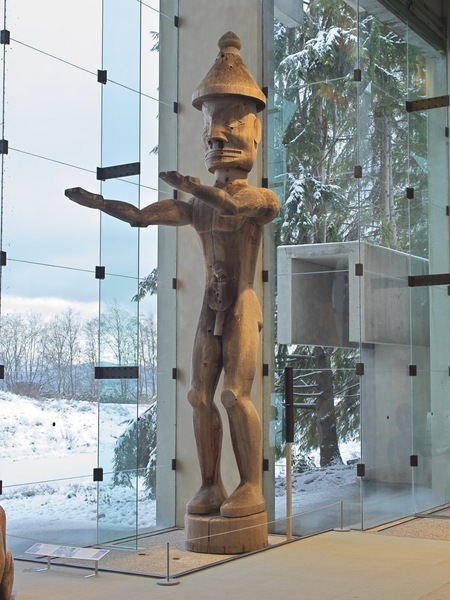Cedar Man Item Number: Nb11.368 from the MOA: University of British Columbia

Description
Tall, carved, welcome figure, standing on a round base. Figure carved with a round west coast style hat and with arms and hands extended to the front, with palms facing upward. Arms are bolted at sides so they can be lowered or raised.
History Of Use
While most welcome figures are carved to greet guests with open arms, this particular piece was created as a form of protest. (See Narrative.) According to Joe David this figure restates the message of a previous figure carved on Meares Island by his great-great-great grandfather. No longer standing, this earlier figure is said to have recorded the statement of an ancestor who lived at the time of the first European contact. This ancestor cautioned other chiefs and community members against the possible dangers of Europeans for indigenous peoples.
Narrative
This particular "welcome" figure was created as a form of protest against the logging of Meares Island, Joe David’s ancestral home. In the words of the artist: “I simply set out to create something that would mark historically and aid the cause of preserving our homeland Meares Island, which was scheduled to be logged…” (1984) The figure was first raised at Tin-Wis in Nuu-chah-nulth territory. With the support of the Tribal Council, the carving was raised a second time in front of the Provincial Parliament Buildings during the Oct. 20,1984 Meares Island anti-logging rally in Victoria. The figure stood at the front of the Museum of Anthroplogy from 1987 to 2008 when it was removed due to construction and a redesign of the museum entrance area. The figure was reinstalled in the Museum's Great Hall in February 2012.
Item History
- Made by Joe David (Maker) and Loren White (Technician) in British Columbia, Canada during 1984
- Owned by Joe David before February 17, 1987
- Received from Joe David (Seller) and Museum of Anthropology Shop Volunteers (Funding source) on February 17, 1987
What
- Name
- Cedar Man
- Identification Number
- Nb11.368
- Type of Item
- figure
- Material
- cedar wood and metal
- Overall
- height 7.0 m, width 1.6 m, depth 2.5 m
Who
- Culture
- Nuu-chah-nulth: Tla-o-qui-aht
- Creator
- Joe David (Maker) and Loren White (Technician)
- Previous Owner
- Joe David
- Received from
- Joe David (Seller) and Museum of Anthropology Shop Volunteers (Funding source)
Where
- Holding Institution
- MOA: University of British Columbia
- Made in
- British Columbia, Canada
When
- Creation Date
- during 1984
- Ownership Date
- before February 17, 1987
- Acquisition Date
- on February 17, 1987
Other
- Condition
- good
- Accession Number
- 1254/0001